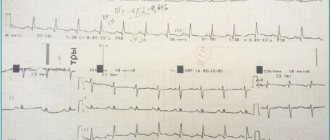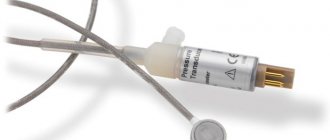Author Marina Lebedeva
10/28/2004 13:33 (Updated: 07/05/2021 13:58)
Health
Hemoglobin level in children is one of the most important indicators of health. How dangerous are deviations from the norm, what could be their cause and are there ways to correct the situation?
What is the difference between “children’s” hemoglobin and “adult” hemoglobin?
Hemoglobin begins to be produced in a child in the womb at the earliest stages of fetal formation. This hemoglobin is fundamentally different from the hemoglobin in the blood of an adult and is called fetal hemoglobin. Shortly before birth, fetal hemoglobin begins to be replaced by the “adult” form of this protein - glycosylated hemoglobin. The complete replacement process is completed at approximately one year of age.
In the first years of life, the norm of hemoglobin in a child’s blood varies significantly depending on age. This indicator must be carefully monitored in order to notice critical deviations from the norm in time.
It is hemoglobin, which contains iron, that gives blood its red color. But not all creatures on Earth have red blood. For example, the blood of octopuses, lobsters and crabs has a blue-green tint because another protein, hemocyanin, which contains copper rather than iron, performs the function of hemoglobin in it.
Methods for determining blood glucose
Taking blood to determine sugar levels
The method of collecting biological material for research is an invasive procedure. It is carried out in a clinical laboratory.
If the family history is complicated, then parents are recommended to purchase a portable analyzer for home use - a glucometer.
If deviations from the norm are detected, parents will be offered:
- repeated blood test, but with the collection of biological material from a vein;
- glucose sensitivity test;
- determination of glycated hemoglobin indicators.
During a standard examination, capillary blood is collected. People come to the laboratory strictly on an empty stomach. Young patients are not even recommended to brush their teeth on the day of the examination.
A glucose tolerance test is performed in a hospital, but hospitalization is not required. 2 venous blood samples are taken. The first is on an empty stomach.
Then a certain amount of grape sugar is taken and after 2 hours a control sampling of biological fluid is carried out.
Glycated hemoglobin is an average indicator. Allows you to determine your sugar level over a long period of time.
How to find out your hemoglobin level?
It is quite easy to detect the hemoglobin level - you just need to donate blood for a general analysis. This test involves determining the hemoglobin concentration, which is measured in grams per liter. To obtain accurate information, blood should be donated before feeding, preferably in the morning. Within one and a half to two hours after feeding, hemoglobin decreases.
There are also indirect signs indicating low hemoglobin in children, in particular,
- pale skin
- and peeling.
The hemoglobin content in capillary blood is 10–20% higher than in venous blood. This must be taken into account when interpreting test results.
How the analysis is performed
To determine the level of iron-containing protein, a clinical blood test will be required. The indicator is measured by analyzing Hb derivatives, which are formed as a result of oxidation and other chemical reactions. After this, the laboratory test is deciphered. There are also several innovative methods that can give a complete picture of a blood test for hemoglobin. Colorimetric, gasometric, and the use of specific reagents are progressive methods.
Attention! Sometimes the level of iron-containing protein has no diagnostic value. In this case, it will be necessary to determine its qualitative composition. For example, glycated hemoglobin.
To make the hemo protein indicator more reliable, simple preparation will be required before taking blood. The patient needs:
- the day before the test, give up sports and any junk food (fatty, sweet, spicy, smoked, salty, etc.);
- stop taking any medications 3-4 days in advance (with your doctor’s permission);
- stop smoking the day before the test;
- Blood is donated in the morning on an empty stomach; it is permissible to drink a small amount of clean water.
Such preparation will allow you to avoid atypical reactions of the body to food, allergens, medications, and physical activity.
What is the normal level of hemoglobin in a child’s blood?
The hemoglobin level in newborns in the first days of life is very high - 180–240 g/l. This is explained by the fact that the baby has a reserve of iron accumulated while still in the womb. In premature babies, hemoglobin is often below normal - 160–220 g/l. Such children have a high risk of anemia - a critical decrease in hemoglobin in the blood.
By the end of the first week, the hemoglobin level in children drops to 160–200 g/l. In the following weeks and months, hemoglobin gradually increases - by the age of one month its norm is already 120–160 g/l, and by the age of one year it is 110–130 g/l.
At 5 years of age, the norm is 110–140 g/l, at 10 years – 120–140 g/l[5].
During puberty, around the age of 15, the level of hemoglobin in children reaches “adult” levels - 125–165 g/l.
Hemoglobin norm for children over 12 years old
Hemoglobin (Hb) is a complex protein that is part of red blood cells. Its main task is to transport oxygen to all tissues and organs. A normal level of Hb in the blood is necessary for the coordinated functioning of the whole body. For children under 12 years of age, the normal hemoglobin level is the same for boys and girls. After 12 years, gender makes its own adjustments to the blood test. Therefore, the norm for boys and girls in adolescence is different.
| Age period | Hb norm for boys (g/l) | Hb norm for girls (g/l) |
| 12-14 years old | 120-160 | 115-150 |
| 15-18 years old | 122-163 | 117-153 |
After age 18, Hb levels for healthy men and women remain stable until age 65.
Causes and signs of increased hemoglobin levels
Various reasons can lead to an increase in the level of hemoglobin in a baby. The most common are:
- dehydration - both as a result of insufficient fluid intake and overheating, and as a result of diarrhea;
- congenital heart diseases, including pulmonary heart failure;
- oncological diseases;
- disturbances in the synthesis of the hormone erythropoietin;
- intestinal obstruction;
- blood diseases.
Sometimes a slightly elevated hemoglobin level can be considered normal. In people living at high altitudes, hemoglobin is slightly increased - this is a reaction to thin air. Also, hemoglobin may be slightly higher than normal in children who are very active in sports.
Children with elevated hemoglobin are usually lethargic and irritable, they suffer from drowsiness and fatigue, and the skin sometimes takes on a reddish tint.
What hemoglobin is considered low (reasons, symptoms)
More often in adolescent children (especially at 16, 15 years old) a decrease in hemoglobin is observed. The symptoms are constant and are caused by hypoxia (insufficient oxygen supply). These include:
- apathy;
- drowsiness;
- weakness;
- depression;
- dyspnea;
- muscle weakness;
- headache;
- cardiopalmus;
- pale skin
- decreased immunity (frequent colds);
- fragility of nails and hair.
Anemia (anemia) is an unpredictable consequence of decreased hemoglobin. The most dangerous degree of anemia is considered to be severe, when the protein concentration decreases to a critically low level (less than 70 g/l).
A decrease in hemoglobin in adolescents may indicate the following pathological conditions:
- unbalanced and unhealthy diet;
- deficiency of iron and folic acid in the body;
- blood loss (due to injury, nosebleeds, menstruation);
- diseases of the gastrointestinal tract (dysbacteriosis);
- autoimmune diseases;
- exposure to toxins;
- taking certain medications;
- impaired production of red blood cells (usually a hereditary factor).
The active growth of adolescents may also be one of the reasons.
What is dangerous about low hemoglobin in a child?
Low hemoglobin in children is more common than high hemoglobin. According to WHO, a lack of hemoglobin - anemia - occurs in 47.4% of preschool children and 25.4% of schoolchildren.
Low hemoglobin in a child is a significant risk factor. It can lead to developmental delays, the development of heart and kidney diseases (they, along with the brain, are the first to suffer from oxygen starvation), disruption of the functioning of the immune system, skin diseases and edema. Without treatment, anemia can result in cardiomyopathy and heart failure, and these pathologies are deadly. With a critical decrease in hemoglobin levels, even a hypoxic coma is possible.
Signs of low hemoglobin in children are numerous, but nonspecific, in other words, they accompany not only anemia, but also many other diseases. In any case, parents should be alert to symptoms such as weakness, lethargy, tearfulness and drowsiness of the baby, decreased appetite, and pale skin. Older children may complain of dizziness and headaches. With low hemoglobin, cognitive functions - memory, ability to concentrate, and learning - are noticeably affected. Many cases of poor academic performance are not due to laziness, but to a lack of iron and low hemoglobin.
You need to take a hemoglobin test regularly, at least once every three months. It is not easy to determine the development of anemia by indirect signs; very often its symptoms are ignored or attributed to other causes.
A blood test for hemoglobin is necessary after any infectious diseases, sudden changes in diet (for example, after prescribing a diet when allergies or gastrointestinal diseases are detected) and any unexpected changes in the baby’s behavior. If your child has suddenly turned from an active and cheerful baby into a sleepyhead and a crybaby, you need to immediately take a referral for analysis.
Low hemoglobin often affects physical development - such children grow slowly and lag behind healthy peers in weight and height.
Sometimes tests show that the child’s hemoglobin is low, and this causes reasonable concern for parents. What can cause low hemoglobin in a child?
Causes of low hemoglobin in children
- Infectious diseases and parasitic lesions.
- Lack of iron in the mother’s diet during pregnancy and lactation or its lack in the child’s diet. Low hemoglobin is often observed in children of women following a vegan diet. Plant foods also contain iron, but it is less absorbed than what is present in animal products.
- Deficiency of vitamins necessary for iron to be absorbed into the blood - these include folic acid and vitamin C. Copper also plays an important role in the absorption of iron.
- Diseases of the digestive system in which iron absorption is impaired.
- Blood loss after injuries and operations, as well as after regular bleeding, such as nasal bleeding.
- Lack of physical activity and fresh air.
- Congenital pathologies, in particular thalassemia.
Grodno Regional Children's Clinical Hospital
Details Published March 25, 2015
Pediatrician of the 5th pediatric department, regional freelance pediatric hematologist Guzarevich V.B.
Iron deficiency anemia in adolescents
Puberty is a period of puberty, maturation, growth and development of the adolescent’s body. It has its own unique characteristics, due to powerful vegetative, endocrine and immune restructuring of the body against the background of a physiological growth spurt, as well as disorders of psychosocial adaptation.
It is at this time that numerous transient functional disorders form and previously hidden organic defects appear: hypothalamic dysfunction, with a wide range of clinical manifestations (vegetative-vascular dystonia, metabolic syndrome, etc.), congenital inferiority of connective tissue (visceroptosis, articular hypermobility, osteochondrosis, etc. .), which contributes to a decrease in adaptation to the influence of the external environment. It should be noted that nosological forms during this age period have significant differences. Thus, diseases of the endocrine, nervous and musculoskeletal systems dominate in adolescents, while infectious and colds are more often registered in young children, and in adults the frequency of neoplasms and diseases of the circulatory system increases. This age is characterized by polysystemic (polymorbidity) diseases. For example, in a girl who considers herself practically healthy, a thorough examination is diagnosed with dysmenorrhea, iron deficiency, poor posture, flat feet, nephroptosis, instability of the cervical spine, chronic tonsillitis, myopia, irritable bowel syndrome with constipation, biliary tract dysfunction, crystalluria. Iron deficiency is one of the pressing problems of adolescence. A decrease in the amount of iron in the body leads to impaired hemoglobin formation, the development of hypochromic anemia and trophic disorders in organs and tissues.
At present, there is no doubt that the main factor contributing to the development of iron deficiency anemia in adolescents is the discrepancy between iron reserves in the body and its needs. Iron deficiency in adolescence is much more common in girls, which may be due to heavy menstruation. However, in cases where the need for iron far exceeds its supply, iron deficiency anemia can also develop in young men. The most common reasons in this case are the intensive growth of a teenager, participation in strenuous sports, initial low iron levels against the background of an unbalanced diet, and vegetarianism. It should be remembered that iron deficiency anemia is often observed in conditions such as anorexia nervosa, diseases of the stomach and duodenum, including those associated with H. pylori, repeated intestinal infections, giardiasis, helminthic infestations, and inflammatory bowel diseases.
Clinical manifestations of iron deficiency anemia are pallor of the skin and mucous membranes, loss of appetite, increased physical and mental fatigue, decreased performance, irritability, emotional instability, increased sweating, dizziness, headaches, tinnitus, flashing “flies” before the eyes, increased heart rate, pain in heart. Characterized by dryness and flaking of the skin, dystrophic changes in the nails, dullness and increased fragility of the hair, “jams” in the corners of the mouth; burning of the tongue, difficulty swallowing solid food, perversion of taste and smell, muscle pain, decreased muscle tone, night and day urinary incontinence due to muscle weakness, constipation. Girls may experience menstrual irregularities.
Diagnosis of iron deficiency anemia is based on a decrease in hemoglobin levels below 120 g/l in a general blood test, as well as a decrease in ferritin (iron reserves in the body) in the blood serum.
In all cases of iron deficiency, it is necessary to establish the immediate cause of its occurrence and, if possible, eliminate it. Treatment should be comprehensive and aimed not only at eliminating anemia as a symptom, but also at eliminating iron deficiency and replenishing its reserves in the body.
It is necessary to enrich a teenager’s diet with foods that are the main sources of iron, and not only the amount of iron in a particular product matters, but also the degree of its absorption and the possibility of assimilation by the body.
Meat, especially red meat (veal, beef, lamb, beef tongue), is the best source of heme iron; 20–25% of iron is absorbed from it. Iron from chicken and pork is absorbed to a lesser extent. And in liver and fish, iron is contained in the form of ferritin and hemosiderin, so it is absorbed even worse.
Non-heme iron (vegetables, fruits, nuts) is poorly absorbed (1–5%), and its absorption is influenced by many factors that can either improve or worsen its absorption. Thus, they enhance the absorption of iron: vitamin C (especially abundant in citrus fruits), hydrochloric acid (found in gastric juice), fructose (fruits, honey). Impair iron absorption: drugs that reduce the acidity of gastric juice (antisecretory drugs, antacids), calcium (a lot in dairy products), oxalates (spinach, cabbage, beets, nuts, chocolate, tea, etc.), polyphenols (cocoa, coffee, black and some types of herbal tea), phytic acid (walnuts, almonds, legumes, bran)
However, once anemia has developed, it cannot be cured with diet alone: iron deficiency anemia is treated with iron supplements. Nutrition helps maintain a normal iron balance in the body after treatment. Preference is given to oral forms of iron supplements, since compared to parenteral administration, the rate of restoration of hemoglobin levels is almost the same, and the number of side effects is sharply reduced. Taking iron supplements is recommended 1 hour before meals, preferably in the evening, since the absorption of iron increases in the second half of the day. The therapeutic effect of oral iron intake appears gradually. The first positive clinical sign is the disappearance or reduction of muscle weakness. On days 8–12 from the start of treatment, the content of reticulocytes in the peripheral blood increases. Normalization of hemoglobin occurs by 4–5 weeks from the start of therapy.
In recent years, in the treatment of iron deficiency conditions in adolescents, a new generation of iron-containing drugs based on the polymaltase complex of ferric hydroxide - Ferrum Lek, Maltofer and Maltofer Fol - has been actively used, which in addition to iron contains folic acid, which takes part in the production of nucleic acids, purines, amino acids, stimulating formation of red blood cells. One of the attractive characteristics of these drugs is their low toxicity. The drugs are well tolerated, have a pleasant taste and are in the form of chewable tablets, which undoubtedly increases adherence to therapy. For iron deficiency anemia, children over 12 years of age and adolescents - 100-200 mg per day, and for latent iron deficiency and for preventive purposes - 50-100 mg per day. The duration of therapy, as a rule, is at least 2 months, which is determined by the degree of iron deficiency in the body and depletion of its reserves, the rate of hematopoiesis, and absorption. In the case of clinically pronounced iron deficiency, normalization of hemoglobin is achieved only 2–3 months after the start of treatment. After normalization of hemeglobin levels, it is necessary to continue taking iron supplements in prophylactic doses to restore internal iron reserves for several months.
The prognosis of the disease is favorable: cure occurs in the vast majority of cases. The problem of iron deficiency is, first of all, a nutritional problem, so the primary prevention of iron deficiency anemia is an adequate, balanced diet for a person at any age.
Prevention of deviations from the norm
The most important measure to prevent the development of complications associated with changes in hemoglobin levels is regular tests and examinations with a pediatrician. Sometimes low or high hemoglobin in a child indicates the presence of serious diseases that require immediate treatment. But a lot also depends on the parents, since deviations from the norm are often found in healthy children due to errors in diet and routine.
Prevention of elevated hemoglobin
- During pregnancy and breastfeeding, mothers should not take vitamin complexes with iron without consulting a doctor. In many cases, supplemental sources of iron are necessary, but it is extremely important not to exceed the recommended dosage.
- Do not buy children's vitamin complexes without consulting your doctor. If a child gets enough iron and vitamins from food, taking extra vitamins and minerals may do more harm than good.
- Review your child's diet - it should contain meat, vegetables and fruits rich in iron.
Preventive measures
Expert advice to help avoid problems with hemoglobin levels in the blood in children and adolescents:
- you need to comply with the drinking regime;
- eat properly and balanced;
- walk more in the fresh air;
- avoid stress and emotional stress;
- engage in a feasible sport;
- observe a rest and wakefulness regime;
- promptly treat viral and infectious diseases;
- take any medications only with the permission of a doctor;
- regularly donate blood for general analysis (at least once a year).
Compliance with these simple rules will help maintain hemoglobin levels within normal limits in children during adolescence.
The reasons for the increase and decrease in hemoglobin in adolescents are different. To avoid problems with hemoprotein, parents need to carefully listen to their children's complaints. Even with minor changes in the child’s health status, you should consult a doctor and conduct a diagnostic test. Proper nutrition and a healthy lifestyle for children are optimal conditions for maintaining normal levels of iron-containing protein.
Lack of blood sugar: causes
A decrease in blood glucose is also a warning sign. Possible causes of this condition:
- long-term fasting, including hidden fasting due to diseases of the gastrointestinal tract;
- lack of fluid in the body;
- diseases of the digestive system - colitis, duodenitis, gastritis;
- history of chronic diseases;
- recent episode of serious illness, condition after injury;
- Insulinoma is a neoplasm in the pancreas that produces excess insulin. This leads to a decrease in sugar levels;
- brain pathologies;
- brain and head injuries;
- intoxication with arsenic compounds, chloroform;
- sarcoidosis is a multiorgan inflammatory process in which granulomas form.
A sharp drop in blood sugar levels affects the child's behavior. At the initial stages there is excitement, the baby asks for something sweet.
If it is impossible to satisfy cravings for carbohydrates, the child develops the following symptoms:
- hyperhidrosis;
- dizziness;
- increasing weakness;
- convulsions;
- loss of consciousness.
Administration of glucose helps improve the child's condition. If this is not done, then a hypoglycemic coma develops. This could end sadly.








